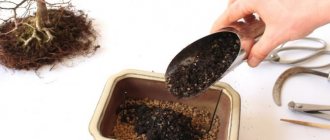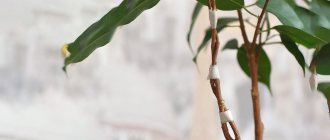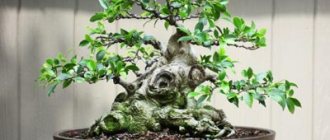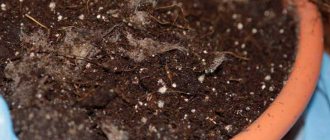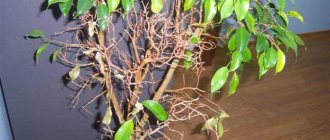When planning to grow their own bonsai at home, many people choose ficus. And this choice is truly justified. Some types of ficus have all the characteristics needed for growing bonsai:
- branched roots;
- interesting, ornate, massive trunks - curved or grooved;
- beautiful bark - light and smooth in some species and more textured and colorful in others;
- rapid growth - you can grow a bonsai from a ficus in two to three years;
- small leaves - not all ficus have small leaves, but we will select ficus species suitable for creating bonsai.
The first step in growing ficus bonsai is to choose the right species .
How to do it: basic rules for growing bonsai
So, you have already selected the ficus of the desired type and even decided what shape you want to give it. But before you start creating bonsai, you need to familiarize yourself with the rules for caring for them.
Choosing a container for planting
Looking at the finished bonsai trees, you probably noticed the containers in which they were grown. When choosing a pot for bonsai, it is very important to maintain harmony in the shape of the plant and the size of the container. The basic rule when creating a traditional bonsai: in most cases, the container should be shallow, almost flat, but wide enough. This way you can avoid the growth of the root system, which entails an increase in the crown and leaf mass.
For planting bonsai, you should choose shallow, almost flat pots.
Soil for planting and growing bonsai
Based on the size and shape of the containers for this type of plant, the soil requirements for them are also determined. You can provide the ficus with the most comfortable existence, close to natural conditions, by planting it in natural soil. Buy ready-made soil for ficus and palm trees at the store or prepare it yourself. To do this you will need only 3 components:
- sand;
- clay;
- humus.
Sand, clay and humus are essential components of a bonsai substrate.
Sand should be of two types - coarse (sand grains 3–4 mm in size) and fine (sand grains 1–2 mm in size):
- Coarse sand will provide drainage, through which excess water during irrigation will flow into the pan. The layer of coarse sand at the bottom of the container should be about 2 cm. You should not take sand with a larger fraction: it will quickly become clogged with small particles of clay, and water drainage will become difficult. Finer sand will simply spill through the mesh on the drainage holes of the container (the size of its cells is no more than 3 mm).
- Fine sand is part of the substrate, sometimes together with coarse sand. When preparing the soil mixture, keep in mind that the proportion of sand in it should be at least 20%, maximum 60%. The more fine sand there is in the soil, the lighter it is, which means the roots in it will not rot. There is also a minus: the plant in such soil can dry out, since it does not retain water for a long time.
Good, high-quality sand of any fraction can be obtained in several ways. For example, get it from the bottom of the river. If this is not possible, then take the red bricks and crush them, then sift them well. Often, instead of sand, fine expanded clay (about 3 mm in diameter) is used.
Now about the clay. Its main function as part of a soil mixture is to retain moisture for the root system and release it at the right time. Japan traditionally uses special types of clays, and bonsai growers from other countries have adopted this practice. The most suitable clay is “Akadama” - a granular substrate whose particle size is 4–6 mm. They absorb a large amount of moisture, but do not get wet or stick together, allowing air to pass through perfectly.
Japanese clay "Akadama" is recommended as a base soil for bonsai
Humus, leaf soil, peat - these soil components will provide your future bonsai with nutrients.
Planting a tree
When replanting ficus Benjamin, purchased in a store, you need to wait 12–15 days, allowing the plant to adapt to the new conditions. The personally rooted cuttings are planted 2–2.5 months after the planting material gives the first roots.
Planting procedure and further care - step-by-step master class
- Cut several apical cuttings 8–12 cm long from a healthy ficus, treat the cut areas by sprinkling them with crushed chalk or activated carbon. Dry for 2-3 hours. Typically, the cutting has 3–4 leaves and 1–2 growth points, from which the plant will later produce aerial roots.
- Place the cuttings in water or a solution of a root formation stimulator (Epin, Kornevin, Topaz, Heteroauxin, potassium humate). If necessary, trim off the lower leaves.
- Provide a constant temperature of 25–27ºС, bright light. If possible, use bottom heating.
- Cover the bottom of the selected bonsai container with a special fabric, similar to a mesh with small cells (2–3 mm). Pour coarse river sand (layer thickness about 0.5 cm) and substrate (no more than 2.5–3 cm) onto it.
- Place the plant in the right place, placing a small stone under the roots, carefully straighten them and sprinkle them with soil, forming a low hill. The soil layer does not reach the top edge of the pot by 1–1.5 cm. Lightly compact the soil. The root collar should be located at ground level. Choose a stone that resembles natural rock as much as possible. A piece of brick or a piece of decorative cladding panel is absolutely not suitable.
- Water the ficus well, and after 25–30 minutes drain the excess moisture from the tray.
- If you plant several cuttings in a pot, they can be intertwined before the trunks become woody. This will not cause any harm to the plants. To consolidate the result, tie the ficuses in the right place, placing a thick soft cloth under the rope or twine. To speed up the process of fusion of cuttings, remove a layer of bark about 0.5 mm thick and use a special spray.
- When the ficus plants have taken root well (after about 4 months), begin to gradually rake away the soil from the roots, gradually exposing them. This will not harm the plant. The older the ficus, the more unnoticeable the procedure is for it.
- When the tree grows to the desired height (in about six months), pinch the top and begin to form the crown.
- If desired, you can decorate the pot with moss, colored pebbles, decorative stone figures, oriental symbols, without covering the inverted roots. But you shouldn't get carried away. An abundance of decorations inevitably distracts attention from the tree itself and is not welcomed by Japanese tradition.
How to grow bonsai from Ficus Microcarpa
Although Ficus Benjamina is considered the most popular when creating a bonsai tree, other species also give good results. For example, Ficus Microcarpa, which is also known by the names: Ginseng (ginseng), blunted, Chinese banyan and even “strangler” - for its ability to entwine surrounding plants with aerial roots and inhibit their growth. The thick trunk of the ficus Microcarpa seems to consist of several intertwined thinner trunks, which attracts bonsai lovers. However, in reality these are thickened aerial roots.
A characteristic feature of ficus is Microcarp - a powerful root system, which is often mistaken for a trunk.
Ginseng for growing bonsai is in many ways even simpler than Ficus Benjamin. To speed up the process of rooting and growth of aerial roots, form a greenhouse over the container with the planted shoot. For example, cover the cutting with a glass jar of suitable size or put a transparent plastic bag over the pot. Every day, open the greenhouse for 20–30 minutes for ventilation.
In July, the ficus Ginseng needs to be replanted. Be sure to shorten the roots by a quarter before planting in new soil.
Ficus Microcarpa needs plenty of sunlight, but direct rays are best avoided. In autumn and winter, provide the plant with fluorescent lamps to keep the daylight hours within 14–16 hours.
Please note that this type of ficus does not like dry hot air. Place the bonsai at a considerable distance from heating devices and heating radiators. Keep the plant away from window sills to protect it from cold drafts.
Do not forget that the leaves of the Ginseng ficus are moderately poisonous. Choose a place for the plant that is inaccessible to children and pets.
The optimal height of a bonsai from the ficus Microcarp is 50 cm. When the tree reaches this size, you can begin to form the crown. As a rule, this occurs in the 3rd–4th year of growth. By this time, the aerial roots will also become quite large. Be sure to prune during growth so that the tree does not stretch upward.
Ficus Microcarpa is incredibly hardy and grows very quickly. Trees appear wherever seeds fall. The plant is found on the roofs of multi-story buildings, on rocks and even in sidewalk cracks.
Radical pruning of the ficus Microcarp allows you to give the bonsai a more spectacular shape.
Do not be alarmed if your Microcarpa ficus begins to shed leaves en masse - this is a characteristic phenomenon for this species. Ginseng's foliage lives for 3 years, after which it falls off, but pretty soon the plant acquires a new crown. And yellowing of the leaves, starting from the lower ones, signals that it is time for the plant to fertilize.
Video: bonsai formed from ficus Ginseng
Transplanting a plant
The process of replanting a bonsai is no different from replanting a regular ficus. Here's what you need to do:
- The day before planting, you need to prepare a new pot and soil.
- The plant needs to be watered so that it can be easily pulled out the next day. The soil is also loosened and weeds are removed.
- The next day, the ficus needs to be placed on its side and gently pressed on the pot in several places.
- Having pulled out the bush with soil, you need to clear the root system of soil. To do this, use a knife or something else to tap the ground.
- Then you can replant the plant.
Important. It is forbidden to water ficus bonsai immediately after transplantation. He is under stress. It is better to moisten the soil after 1-2 days. It is forbidden to fertilize for a month if purchased land was used, since it is already sufficiently enriched.
Thus, ficus bonsai are considered quite popular today. Even beginners can grow several of these plants for themselves, especially since the trend is completely new and popular. They are happy to buy ready-made plants at the market. However, you need to understand that bonsai is an art. If you do everything correctly and be patient, then you can enjoy the result.
5/5 — (1 vote)
Bonsai from other types of ficus: Bengal, Fig, Panda, Rubber, etc.
You can create an original and spectacular bonsai from other types of ficus, but you need to take into account some nuances:
- Bengal ficus. It is also called banyan because of its specific shape: one plant looks like a whole grove. This is why the Bengal ficus is valuable among bonsai lovers. You can also form a grove from other species, but it is easier to get a bonsai from the Bengal ficus, and it will look more impressive. Leaves with a variegated pattern will add decorativeness to the composition.
- Ficus Panda has very dense leaf plates, giving the bonsai a special originality. The tree tolerates dry air very calmly, so it will take root well in a city apartment.
- Fig ficus, or Carica (wineberry, fig tree). This species has thick branches, so pruning the plant is difficult. The leaves are large, but decrease in size over time - this is a plus for bonsai. The downside is that the fig ficus sheds its leaves in the winter. But in the summer it quickly gains new strength, especially if it is taken out into the open air.
- Ficus rubber plant. Not all representatives of this species are suitable for creating bonsai. Experts prefer to use specially bred hybrids with different color patterns on the leaves. The leaves of the rubber ficus grow quickly and are arranged in a spiral, which is good for the formation of a bonsai tree. The plant is demanding of lighting and does not tolerate changing it, so you should keep the rubber ficus bonsai in the same place. Do not forget that the juice of this species is poisonous: do the pruning with gloves and sprinkle the cut areas with activated carbon.
- The rusty-red ficus is distinguished by smooth reddish bark and leaves covered on the inside with red hair. This species grows very slowly, but you do not have to do frequent pruning. The stems of the Rusty Red Ficus, like the Ficus Bengali, form a banyan tree, but not very pronounced. The plant is very hardy, mistakes in care are not critical.
Tree shapes
It is very important to think in advance what shape the plant will have. Indiscriminate pruning of branches will lead to nothing; you may even destroy the sprout. The wise Japanese have already come up with all possible forms. All you have to do is choose the appropriate style and act strictly step by step.
Basic bonsai styles:
- Tekkan;
- moyogi;
- Syakan;
- Sokan;
- Hokidachi;
- Yesueue.
Tekkan
The Tekkan shape is classic, pyramidal. It is characterized by a straight trunk. The Japanese believe that Tekkan is a style suggested by nature itself. This is what trees growing in open areas look like. They develop harmoniously because they have enough light and nutrients.
Main characteristics of the Tekkan style:
- straight trunk with a lower part free from branches;
- proportionally developed branches without strong bends;
- powerful root system;
- harmonious pyramidal crown.
Attention! Crown modeling in the Tekkan style is the easiest option for beginners.
Moyogi
The moyogi style is characterized by a slight curvature of the trunk. The appearance of the ficus resembles Tekkan. The plant is upright, with straight branches and a harmonious crown, but the trunk does not look as regular as in the Tekkan style. It bends in one or more places. This gives the tree a more romantic look.
Main characteristics of moyogi style:
- the trunk consists of several curved lines;
- the trunk decreases proportionally from the base to the top;
- the crown is balanced in relation to the trunk.
Syakan (inverted)
Very interesting shape! An inexperienced gardener is unlikely to achieve such an effect. The tree looks as if it had been slightly tilted to the side by a strong wind. On the opposite side, the roots are exposed, their texture is clearly visible.
Features of the Shakan form:
- the slope of the tree is at least 30 degrees;
- the crown is more developed on the outer (upper) part of the plant;
- the shape of the branches follows the logic of inclination.
Sokan (double barrel)
In this case, the tree has two trunks. The first is more powerful; the Japanese call it “parent”. The second one is smaller, this is “child”. The skill of a florist is to grow a tree with powerful trunks that match each other in shape.
Features of the Sokan style:
- forked trunk;
- common root system;
- separation begins as close to the roots as possible.
Hokidachi (broom shape)
The tree, grown in the shape of Hokidachi, resembles a broom. This is difficult to achieve, although such a bonsai looks quite natural. This style has many requirements: it is important that the branches and roots radiate equally from the trunk.
Hokidachi design features:
- branches do not intersect each other;
- branches grow at the same distance from each other;
- spherical shape of the top.
Esueue (forest grove)
This style assumes that the gardener grows not one, but several types of trees in one container. It is no coincidence that the name of the style means “forest grove” in Japanese.
Main features of the Yesueue style:
- number of trees – at least five;
- plants of different ages;
- the oldest and most powerful plant is planted in the center.
Getting rid of diseases and pests
The most common problems that beset bonsai trees grown from ficus trees are drying out roots and falling leaves. Other problems may occur, but they are all caused by pests or diseases.
- The most malicious and most frequent enemies of ficus are scale insects. If you notice black or brown cones on the branches with a coating similar to wax, know that they are where insects are located.
- Another person who likes to parasitize ficus trees is mites. Take a closer look at the leaves of the plant. If you see red or brown moving dots, then ticks have already come to you. For now, there is nothing particularly to be afraid of: there are still a few insects, you can deal with them by wiping the leaves and branches with a soapy solution. But if you find a cobweb on a ficus tree, you will have to work more thoroughly.
Drying roots and falling leaves of a ficus bonsai eloquently indicate a plant disease - Mealybugs appear on ficus trees less often than their parasitic counterparts mites and scale insects, but this does not make it any easier for you and me. You can find them in the form of fluffy white formations on the roots and at the base of the leaves.
If we are talking about other plants, then insecticides are used to treat them from the listed misfortunes. The problem with ficus trees is that they do not tolerate substances containing malathion. Therefore, when choosing an insecticide, choose one that contains neem oil.
If the ficus bonsai began to lose leaves, then the reasons may be as follows:
- high humidity;
- excessive dryness;
- frequent drafts;
- regular exposure to bright sunlight.
If the ficus leaves begin to turn yellow, you should change the watering or lighting mode
Move the ficus pot to a lightly shaded area out of direct sunlight. There should be no drafts or access to cold air in the room; there should be a constant temperature within +19 - +22°C. Let the soil dry thoroughly, and only then water the plant with a small amount of water, but often. After 3-4 weeks, the leaves will stop falling.
If the roots of a ficus bonsai begin to dry out, then this is most likely due to improper watering. Try spraying it generously with a spray bottle for a while (2-3 weeks) after the soil has completely dried out, so that it is thoroughly moistened. The next watering is in the same way, after the soil has noticeably dried out.
Forming the crown
The crown of a bonsai is formed by constantly trimming the main trunk. Thanks to this procedure, the crown begins to grow not in height, but in width, the aerial roots and trunk become wider.
You need to start forming a crown no earlier than six months after planting. The ficus must become stronger before the crown pruning procedure.
Bonsai tools.
Bonsai can be formed even with the help of ordinary gardening tools, but for those who decide to approach this issue thoroughly, it is better to purchase the necessary tools.
- - needle-nose pliers, straight and oblique. Straight needle-nose pliers are used to trim small branches located at the branching level. They can also be used to trim roots. Straight needle-nose pliers leave behind an even cut. Oblique ones are used to remove thick branches. This tool resembles jaws. Using oblique needle-nose pliers, you can make a clean cut on the stem. Sometimes oblique needle-nose pliers are used to cut wire, but it is better to purchase special pliers or ligature pliers for this purpose.
- - short scissors. Short shears are usually used to remove dead leaves. This is a very convenient tool. Sometimes it is also used to remove weeds that appear in the container with the tree.
- - other types of scissors . In addition to the short scissors mentioned, large scissors are used. With their help, young shoots of the plant are pinched, leaves and shoots are removed. Thin long scissors are used for precise cutting.
- - digger-hook . A special hook digger is used to loosen soil in small containers or to loosen soil between roots. Other soil management tools include a plow and trowel.
- - wire cutters. In order to “age” existing wood, special techniques have been developed. These techniques require the use of special tools. Using pliers, remove the bark from part of the trunk ("shari" technique) or from part of the branch ("jin" technique), exposing the wood. The bark is removed above the soil level.
- - rotating tables. Thanks to such tables, you can easily reach the tree from any side. There are tables whose height can be adjusted.
- - additional tools . A sieve with holes with a diameter of 6 mm will help to sift the soil before planting the plant, and a special whisk (it is most often made from coconut palm fibers) helps to properly shape the surface after planting the plant.
- - wire and wire mesh. Copper or brass wire is used to form branches and trunks. If you are dealing with a plant that has delicate bark, then use plastic-coated wire. Lay a regular fine-mesh mesh on the bottom of the containers. Most often, zinc mesh is used for this. However, you can use, for example, plastic - it is cheaper, lighter, more durable, and is not afraid of rust.
Bonsai pots
Depending on the type and age of the tree, you need to choose the most suitable container. Young trees are grown in ordinary containers, and then, after the plants have formed, they are transplanted into the most suitable container.
- - containers for bonsai can vary in size - there are very small containers and containers with a diameter of 60 cm for creating a miniature landscape sketch. The following should be taken as a rule: the height of the container should be equal to half the height of the tree.
- — flat containers are used to create landscape sketches. And thanks to the tall containers, you can emphasize the beauty of cascade-type compositions.
- — the stand for the container can be flat or on legs. Straight legs located on the sides give a feeling of stability, legs with ornaments give the composition elegance.
Containers stylized as antique vessels, as well as their cheaper copies, can bear a simple design. Most often, clay, stone or ceramic containers are used for planting bonsai, but you can also use, for example, wooden containers. The outer surface of clay containers can be glazed, but the inner surface should not be glazed so that the porous walls of the container can absorb moisture.
Reproduction
The most popular and easiest way to propagate microcarp bonsai is cuttings.
Initially, you need to select the strongest and most developed stems, from which the tops with leaf cover are cut off. Cuttings need to be placed in water. To create greenhouse conditions, the cuttings can be covered with film or a jar. In about a month, the plants will have their first roots. Now the bonsai can be planted in the ground. Plants grown in this way require annual replanting until they mature to 3-4 years of age.
Features of growing at home. Briefly
A tree with unusual thick roots and lush hair attracts attention. To make the plant beautiful, you need to take care of the ficus microcarpa. At home, basic conditions are created for him:
| Temperature | In winter – not lower than + 16°C, in summer – up to + 23°C. |
| Air humidity | Increased throughout the year. |
| Lighting | Bright diffused; shade on the south window. |
| Watering | The substrate should dry out between waterings, but do not allow a crust to form on the soil. |
| Priming | Ready substrate for ficus; a soil mixture of turf soil, peat, leaf soil, and sand taken in equal quantities. |
| Feeding and fertilizer | From the first days of March until the very end of August, fertilizer is applied to ficus plants once every two weeks. |
| Transplanting ficus microcarp | Young trees - every spring, adults - once every 2.5 years. |
| Reproduction | By seeds, air layering, root cuttings, cuttings. |
| Features of cultivation | The plant gets used to growing in one place; forced rearrangements cause stress. In the summer, they take it outside, placing the container with the plant in a place protected from the wind. In the spring, shoots are pruned, leaving 4 leaves on each of them. |
Proper pruning and other nuances of tree care
How to trim and shape the crown?
Pruning is a procedure without which it will not be possible to make a bonsai from Ficus Benjamin. They usually start with aerial roots, giving them the desired shape, regularly cutting off the main trunk of the plant. Because of this, it begins to increase in diameter, the crown grows in breadth, the roots thicken and partially protrude from the ground.
You can begin to form the crown only when the trunk reaches the required thickness. Since Ficus Benjamin intensively forms green mass, it needs to be pruned at least once every six months. Each branch on which 8–10 new leaves have appeared is shortened so that 2–4 leaves remain. Pruning is done from bottom to top. The juice released at the cut site does not need to be washed off.
To minimize stress on the plant, use only sharp, disinfected scissors with blades that are not too long, cutting branches perpendicularly without leaving stumps. When the released juice thickens, lubricate the “wounds” with garden varnish.
Under no circumstances should you cut off just the leaves. A “bald” bonsai with bare branches sticking out in different directions looks, without exaggeration, terrible. In addition, the remaining leaves may turn brown.
Do not overdo it when trimming leaves - a “bald” bonsai does not look very attractive
The best time to remove a significant amount of green mass is early spring, before the active growing season begins. Then, until autumn, you can carry out small “routine repairs”, removing individual poorly located branches or correcting the direction of their growth. From mid-October until the end of winter, Ficus Benjamin is not pruned - this is too much stress for a plant that needs a period of rest.
The shape of the trunk must be given as carefully as possible. The best option is to use a thin rope or twine, tying the necessary branches to the base of the tree or to another support.
In order for a ficus bonsai to acquire a trunk with characteristic curves, you need to use gentle shaping methods
If you still decide to use wire, take the thinnest one available, with insulation and be sure to place a soft cloth under it. Do not wrap ficus benjamina with wire immediately after transplantation, wait 3-4 weeks. Move strictly from the bottom up from the base of the trunk. When the plant is able to maintain the desired shape (after 1.5–2 months), carefully cut the wire and remove it. There is no need to even try to unwind it - you will almost certainly break off the branches.
Those who are confident in their abilities can try to “correct” nature by transplanting one or more shoots of other species onto Ficus Benjamin. Some craftsmen manage to transplant even aerial roots.
Video: trunk formation and pruning of ficus benjamina bonsai
Important care details
Ficus bonsai is cared for in the same way as a normal sized plant. It also needs watering, increasing air humidity, and regular fertilization. Creating optimal conditions for the plant is no less important than caring for it.
For harmonious development, it is advisable to provide at least 12 hours of daylight. During the active growing season, if there is not enough natural sun, use special phytolamps. For autumn and winter, avoid lighting.
Choose a place for your bonsai immediately and forever. Ficus reacts poorly to movement, abruptly dropping leaves. Make sure that the pot is not in a draft. Ensure a constant temperature of 18–25ºС, try to avoid sudden changes. 15ºС is the survival threshold for Ficus Benjamin.
Any bonsai is watered quite moderately so as not to cause root rot. Ficus Benjamina is no exception. Use rain, melt or well-settled water. It is advisable to pass the latter through a filter or soften it with several crystals of citric acid. To ensure that the soil is saturated with moisture evenly, water is sprayed onto the bonsai from a fairly large height using a spray bottle. Thus, at the same time you moisten the crown of the tree. Miniature ficus is watered daily or once every 2 days (depending on the temperature and humidity indoors and outdoors) as soon as the top layer of soil is completely dry.
Ficus benjamina bonsai loves moisture, but in everything you need to know in moderation
The dense, fleshy leaves of the ficus help it endure the dry air of modern apartments, but for rapid growth and harmonious development, it is recommended to increase the air humidity in the room using affordable methods. This is a necessary condition for the appearance of aerial roots, which give the bonsai originality.
If there is no winter garden or greenhouse in the house, a good place for a mini-ficus is the kitchen. The air humidity there is higher than in other rooms.
Bonsai are fed with fertilizers only during the active growing season, from early spring to mid-autumn. Ideally, you need to find special mixtures for this type of indoor plants, but complex fertilizers for palm trees or mulberries are also suitable. The fertilizer is dissolved in water, strictly following the manufacturer’s recommendations. The preferred option for its application is foliar. Once every 15–20 days is enough.
It is advisable to feed ficus bonsai with fertilizers specifically designed for this type of plant.
Transfer
Bonsais under 5 years of age need to be replanted every 2 years, mature trees - once every 5 years. Focus on the roots of the plant - if they stick out from the drainage holes in the pot, the Benjamin ficus clearly needs to be replanted. In the process, shorten the roots by a third - this stimulates the growth and branching of the ficus.
They try not to disturb any bonsai unless absolutely necessary; be prepared for the fact that your ficus may shed its leaves after the procedure
In general, the plant reacts negatively to transplantation, inevitably becoming “bald”, so it is not recommended to disturb Benjamin’s ficus unless absolutely necessary. The procedure can be completely replaced by removing the top layer of soil in the pot (about 1 cm) and adding a portion of freshly prepared substrate.

